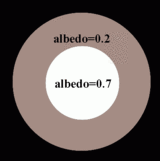(386723) 2009 YE7
| Discovery[1] | |
|---|---|
| Discovered by | David Rabinowitz |
| Discovery date | December 17, 2009 |
| Designations | |
| MPC designation | 2009 YE7 |
|
TNO Cubewano[2] Haumea family[3][4] | |
| Orbital characteristics[5] | |
| Epoch July 23, 2010 (2455400.5) | |
| Aphelion | 50.7 AU (Q) |
| Perihelion | 38.3 AU (q) |
| 44.5 AU (a) | |
| Eccentricity | 0.14 |
| 297 yr | |
Average orbital speed | 4.47 |
| 177° (M) | |
| Inclination | 29.1° |
| 141° | |
| 97.3° | |
| Physical characteristics | |
| Dimensions | 200[6]–560[7] km[5][8] |
| Albedo | assume 0.7 to 0.09 |
| ≈21.7(JPL Horizons) | |
| 4.2[5] | |
|
| |
(386723) 2009 YE7 is a trans-Neptunian object with an absolute magnitude (H) of 4.25.[5] However, it only qualifies as a weak dwarf-planet candidate, since it is also suspected of being a highly reflective icy member of the Haumea family.[3][4] It was discovered by David Rabinowitz on December 17, 2009 at the La Silla Observatory in Chile. When 2009 YE7 was first discovered, it was believed to have an absolute magnitude (H) of 2.8, which would have made it the first bright KBO found from the southern hemisphere.[9]
Orbit
It came to perihelion around 1868.[5] It is currently 50.7 AU from the Sun and will come to aphelion (furthest distance from the Sun) in 2015.
Physical characteristics
Absolute magnitude

The size of an object can be ascertained once its absolute magnitude (H) and its albedo (the proportion of light it reflects) are known. 2009 YE7 has an absolute magnitude (H) of 4.25.[5] Since 2009 YE7 has an absolute magnitude dimmer than (H=1), it will not be overseen by two naming committees and will not automatically be listed as a dwarf planet by the International Astronomical Union (IAU).[10]
2009 YE7 has been found to be a member of the Haumea family fragment due to its Haumea-like orbit and the detection of water ice on its surface.[3] This means 2009 YE7 could have an albedo of up to 0.7, resulting in a small size close to 200 kilometres (120 mi). However, its actual albedo is unknown. If its albedo turns out lower, it would result in a larger size estimate.
Any icy body with a diameter greater than 400 kilometres (250 mi) is likely spherical.[11] Many small icy low-density moons are known to be spherical.
See also
- (55636) 2002 TX300, known Haumea-family member
- Spitzer dwarf-planet candidates with estimated diameter > 600 kilometres (370 mi)
References
- ↑ "List of Transneptunian Objects". IAU Minor Planet Center. 2009-12-28. Retrieved 2009-12-28.
- ↑ "2009 YE7 Orbit". IAU Minor Planet Center. Retrieved 2014-04-02.
- ↑ 3.0 3.1 3.2 Trujillo, Sheppard and Schaller (14 February 2011). "A Photometric System for Detection of Water and Methane Ices on Kuiper Belt Objects". The Astrophysical Journal. arXiv:1102.1971. Bibcode:2011ApJ...730..105T. doi:10.1088/0004-637X/730/2/105.
- ↑ 4.0 4.1 Mike Brown (2009-12-29). "A ghost of Christmas past". Mike Brown's Planets (blog). Archived from the original on 2 January 2010. Retrieved 2009-12-29.
- ↑ 5.0 5.1 5.2 5.3 5.4 5.5 "JPL Small-Body Database Browser: 386723 (2009 YE7)" (last observation: 2010-09-12). Retrieved 2010-09-13.
- ↑ Assuming a Haumea-like albedo of 0.7
- ↑ Assuming an unlikely albedo of 0.09
- ↑ Dan Bruton. "Conversion of Absolute Magnitude to Diameter for Minor Planets". Department of Physics & Astronomy (Stephen F. Austin State University). Archived from the original on 18 December 2008. Retrieved 2009-01-07.
- ↑ "JPL Small-Body Database Search Engine (H<=4)". 2009-12-27. Retrieved 2009-12-27.
- ↑ "Plutoid chosen as name for Solar System objects like Pluto" (Press release). Retrieved 28 December 2009.
- ↑ Mike Brown. "The Dwarf Planets". Archived from the original on 9 January 2010. Retrieved 2009-12-28.
External links
- Orbital simulation from JPL (Java) / Horizons Ephemeris
| ||||||||||||||||||||
| ||||||||||||||
